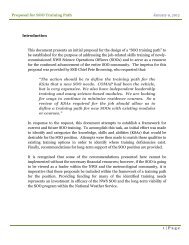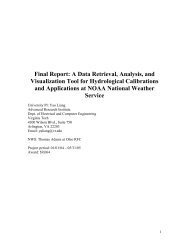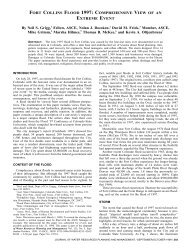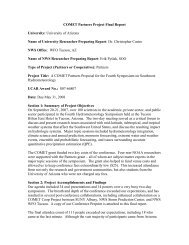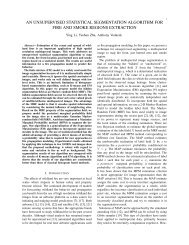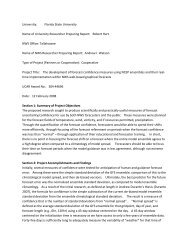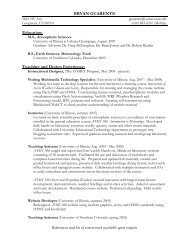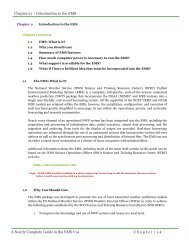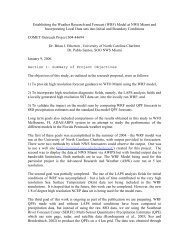The COMET Outreach Program Final Report 1. Summary of Project ...
The COMET Outreach Program Final Report 1. Summary of Project ...
The COMET Outreach Program Final Report 1. Summary of Project ...
You also want an ePaper? Increase the reach of your titles
YUMPU automatically turns print PDFs into web optimized ePapers that Google loves.
<strong>The</strong> <strong>COMET</strong> <strong>Outreach</strong> <strong>Program</strong><br />
<strong>Final</strong> <strong>Report</strong><br />
University: Stony Brook University / SUNY<br />
University Researcher: Dr. Brian A. Colle<br />
NWS Offices: Upton, NY, Mt. Holly, NJ, Taunton, MA, and Northeast River Forecast Center<br />
Title: “Application <strong>of</strong> numerical model verification and ensemble techniques to improve operational<br />
weather forecasting”<br />
Collaborative <strong>Project</strong>: UCAR Award No: S0238662<br />
Date: March 24, 2006<br />
<strong>1.</strong> <strong>Summary</strong> <strong>of</strong> <strong>Project</strong> Objectives<br />
<strong>The</strong> primary objective <strong>of</strong> this project was to improve operational weather forecasting<br />
over the Northeast U.S. using both ensemble modeling and verification approaches. This was<br />
accomplished using the Penn State-National Center for Atmospheric Research mesoscale model<br />
(MM5) and Weather Research and Forecasting (WRF) models. An ensemble system has been<br />
setup over the Northeast U.S., in which the MM5 and WRF are run down to 12-km grid spacing<br />
using a variety <strong>of</strong> physics and initial conditions. This data has been and will continue to be<br />
provided to our operational NWS partners in real-time for various meteorological and<br />
hydrological applications. <strong>The</strong> ensemble system is augmented by the workstation Eta (WSeta)<br />
and WRF (WSwrf) at a few WFOs, and this multi-model approach serves as useful forecaster<br />
training in the areas <strong>of</strong> mesoscale and ensemble modeling. <strong>The</strong> 48-h ensemble forecasts for<br />
particular warm and cool seasons were verified against conventional observations, and these<br />
results were compared with other published ensemble systems and operational NCEP models.<br />
<strong>The</strong> ensemble output was also used to test a variety <strong>of</strong> post-processing approaches to remove<br />
ensemble biases. <strong>The</strong> verification <strong>of</strong> these models was also developed in real-time for the<br />
forecasters to use. Case studies <strong>of</strong> particular events highlighted their predictability as well as<br />
various mesoscale structures, such as the sea breeze, precipitation banding within extratropical<br />
cyclones, and convection.<br />
2. <strong>Project</strong> Accomplishments/Findings<br />
a. Development and verification <strong>of</strong> Stony Brook University (SBU) ensemble system<br />
During the first year <strong>of</strong> the project (2002-2003) SBU developed an 18-member MM5<br />
ensemble operationally at 36 and 12 km grid spacing over the Northeast U.S. for the 0000 UTC<br />
cycle. <strong>The</strong>re were 12 physics (PHYS) members and 7 different initialization condition (IC)<br />
members. <strong>The</strong> PHYS members were setup in a 3 by 4 matrix <strong>of</strong> three boundary layer<br />
parameterizations (MRF, Blackadar, and Eta) and four convective parameterizations (Grell,<br />
Kain-Fritsch, new Kain-Fritsch, and Betts-Miller). <strong>The</strong> seven IC members consist <strong>of</strong><br />
initializations and boundary conditions from NCEP’s 0000 UTC Eta, 0000 UTC GFS and five<br />
Eta members <strong>of</strong> the 2100 UTC Short-Range Ensemble Forecast System (SREF). <strong>The</strong> two<br />
positive perturbations, two negative, and a control from the Eta SREF were utilized. This system<br />
ran for over two years and provided a long-term verification dataset to: (1) evaluate the<br />
strengths/weaknesses <strong>of</strong> using both physics and IC ensemble members over the Northeast, (2)<br />
determine the skill <strong>of</strong> the various physics parameterizations in MM5, and (3) quantify the<br />
benefits <strong>of</strong> post-processing.
<strong>The</strong> ensemble skill was evaluated over the Northeast U.S. during the warm and cool<br />
seasons. For 2-m temperature and wind speed during the warm season, the inclusion <strong>of</strong> a PHYS<br />
ensemble reduced the root-mean square errors (RMSEs) as compared to the IC sub-ensemble and<br />
control (CTL) run, while the full ensemble mean (ALL) had comparable errors to a CTL run<br />
initialized 12-h later (CTL12). In order to get more dramatic ensemble improvements (15-25%),<br />
which outperformed the CTL12 for many times, a 14-day bias correction was applied to the ALL<br />
ensemble (ALLBC). In contrast, during the cool season, the PHYS ensembles and ALL showed<br />
little improvement over the CTL and CTL12 for temperature. Sea-level pressure also showed<br />
little skill improvement <strong>of</strong> the ensemble means relative to the CTL forecast for both seasons,<br />
while the ALLBC resulted in a dramatic (30-50%) reduction in CTL RMSEs, and ALLBC<br />
outperformed the CTL12 forecast. <strong>The</strong> PHYS ensemble had better (higher) equitable threat<br />
scores (ETSs) for 24-h precipitation than the IC members and the CTL during the warm season,<br />
but the percentage benefit for the PHYS was smaller in the cool season.<br />
<strong>The</strong> probabilistic skill and reliability <strong>of</strong> the ALL, PHYS, and IC ensembles were also<br />
evaluated for temperature and sea-level pressure. <strong>The</strong> raw ensembles had little probabilistic skill<br />
or reliability for warm season maximum temperatures near 30 o C, but after bias correction<br />
(ALLBC) there was moderate skill and reliability. Many ensemble members shared a similar<br />
warm bias, especially at night, which led to probabilistic overprediction. Sea-level pressure<br />
probabilities were better for the PHYS and ALL ensembles during the warm season, while the IC<br />
ensemble was comparable during the cool season. <strong>The</strong> ensembles had poor reliability during the<br />
warm season for pressures less than 1010 mb and cool season pressures greater than 1024 mb.<br />
Probability forecasts <strong>of</strong> 24-h accumulated precipitation had better skill than<br />
climatological frequencies for warm season rain event thresholds below <strong>1.</strong>78 cm (0.7") for the IC<br />
and PHYS ensembles, and for all thresholds for the ALL ensemble. In the cool season, the ALL<br />
probabilistic skill was similar to the IC ensemble, while the PHYS ensemble had the lowest skill.<br />
During the warm season the ALL ensemble had greater reliability for 24-h precipitation<br />
probabilities than both the IC and PHYS ensembles for most thresholds. <strong>The</strong> SBU SREF has<br />
some ability to predict forecast skill and estimate the uncertainty <strong>of</strong> a forecast through ensemble<br />
variance; however, the inherent problem in model bias and clustering limited the ability to<br />
predict forecast skill and to estimate the uncertainty <strong>of</strong> a forecast. <strong>The</strong> surface temperature, wind<br />
speed, and sea-level pressure ensemble forecasts showed the worst error-variance correlations,<br />
with correlation coefficients generally less than 0.35. Under-dispersion still remained even after<br />
calibration, with spread-error correlations for 2-m temperature <strong>of</strong> about 0.4 during the warm<br />
season. In contrast, correlations are largest for 10-meter wind direction (0.6 to 0.7), thus<br />
indicating that ensemble variance can be used as an approximation for ensemble uncertainty.<br />
<strong>The</strong> performance <strong>of</strong> this ensemble system is similar to others recently documented, such<br />
as over the Pacific Northwest, with large model biases degrading ensemble performance and current<br />
post-processing techniques removing only a portion <strong>of</strong> this bias. <strong>The</strong> complexity <strong>of</strong> this<br />
problem was illustrated by showing that biases from one parameterization can impact another.<br />
For example, during the warm season the magnitude <strong>of</strong> the cool surface bias for the MYJ-PBL<br />
during the day strongly depends on what CP scheme is used. <strong>The</strong> SBU IC ensemble also suffered<br />
from the large pressure errors intialized in the NCEP SREF bred members. Our collaborative<br />
group alerted NCEP (Dr. Jun Du) <strong>of</strong> many cases in which the pressure field from some SREF<br />
members was much larger than the analysis uncertainty given the observations available.<br />
<strong>The</strong> above results have been submitted to Weather and Forecasting (Jones et al. 2006),<br />
and we have more recently modified the ensemble in 2005 in order to include a mixed physics,<br />
IC, model ensemble. <strong>The</strong> WRF model has been included for the 0000 UTC cycle at 36- and 12-<br />
km grid spacing over the Northeast. <strong>The</strong> ensemble now consists <strong>of</strong> 15 members (9 MM5 and 6<br />
WRF) using the NAM, GFS, NOGAPS, and CMC gridded analyses/forecasts for initial and<br />
boundary conditions, with each member using different convective parameterization, boundary<br />
layer, and microphysics changes. <strong>The</strong>refore, we now have a multi-model/physics/IC ensemble<br />
that will useful for collaborative research during the next few years.
. Ensemble into forecast operations<br />
Several different approaches were used to get the SBU ensemble data into NWS forecast<br />
operations. A web page (http://fractus.msrc.sunysb.edu/mm5rte) has been maintained since 2003<br />
to show the various ensemble member solutions, and this page has recently been modified to<br />
reflect the new ensemble changes. During the past few years various diagnostic fields were<br />
added given forecaster interest, such as mid-level frontogenesis, slantwise instability, and modelderived<br />
reflectivities. A statistical website (http://fractus.msrc.sunysb.edu/mm5rte/enstats.html)<br />
was also available to the forecasters in this project; however, this site is now being replaced by<br />
adding the statistics (mean and spread) to the main ensemble web page using a separate stats<br />
button.<br />
In collaboration with the Northeast River Forecast Center (NERFC), hourly precipitation<br />
from all ensemble members at 12-km grid spacing was made available on a ftp site for 4 river<br />
basins over New England. <strong>The</strong> NERFC used the ensemble member precipitation data in realtime<br />
to generate probability hydrographs over the region on an experimental web page during the<br />
project.<br />
A significant problem during the project was bandwidth considerations that prevented<br />
timely and complete file transfers <strong>of</strong> model data to the WFO’s. This was resolved for WFO<br />
Upton, NY, but other WFO’s remain unable to transfer full model data sets. With assistance<br />
from Eastern Region Headquarters, a condensed data file <strong>of</strong> MM5 ensemble mean and spread<br />
data was converted into netcdf format in order to ingest into AWIPS at all WFO’s. <strong>The</strong> data is<br />
available via ftp from SBU. An undergraduate student (Mike Charles) helped develop AWIPS<br />
procedures to display the ensemble data in combination with other basic fields.<br />
<strong>The</strong> NWS forecast partners also explored their own mini-ensemble predictions using in<br />
house Linux workstations. All <strong>of</strong>fices ran a workstation Eta in real-time to augment the<br />
university ensemble and the NCEP model suite. <strong>The</strong> workstation Eta was setup using the Kain-<br />
Fritsch CP rather than the Betts-Miller-Janic in NCEP operations. More recently, the workstation<br />
WRF has been setup to run at the Upton, NY WFO. Both the workstation Eta and WRF data are<br />
being ingested into AWIPS.<br />
c. Real-time verification and post-processing<br />
<strong>The</strong> 24-h forecast from the previous days ensemble was verified each day. Each member<br />
was verified against surface stations within the 12-km domain, and the results were averaged for<br />
each forecast hour. Time series <strong>of</strong> ensemble mean and mean absolute errors <strong>of</strong> temperature,<br />
windspeed, and sea-level pressure were placed on a web page during the project. <strong>The</strong> verification<br />
page also allowed a forecaster to look back at the previous 2-week to 2-month performance <strong>of</strong><br />
the ensemble members. This page needs to be redone based on the new ensemble just created.<br />
In order to monitor the daily NCEP model initializations over the eastern U.S. and<br />
western Atlantic, SBU collaborated with Dr. Lynn McMurdie at the University <strong>of</strong> Washington<br />
(UW). As a part <strong>of</strong> a previous <strong>COMET</strong> project, UW has been running a real-time model<br />
initialization verification page for the eastern Pacific and West Coast<br />
(http://www.atmos.washington.edu/~bnewkirk/). This page was modified to include a separate<br />
section for verification <strong>of</strong> the GFS and Eta (NAM) model initializations over the Eastern U.S.<br />
using ACARS data, satellite winds, surface data, and rawinsondes.<br />
A variety <strong>of</strong> post-processing approaches have been tested for the MM5 ensemble. A 14-<br />
day bias correction to the ensemble was developed for variables such as windspeed and temperature.<br />
This was constructed by subtracting the average model bias averaged for the past 14 days<br />
for a particular forecast hour and station for each ensemble member, and then averaging all<br />
members <strong>of</strong> a particular group (physics, ICs, or all members). In addition, Model Output<br />
Statistics (MOS) were derived for the warm season using data from the 2003, 2004 and 2005<br />
summers. <strong>The</strong> MOS uses six surface variables (temperature, wind speed, direction, sea-level<br />
pressure, relative humidity, and precipitation) to derive the regression equations. To construct<br />
the MM5 MOS equations, the 3 warm seasons were separated into 6 periods. All six periods<br />
were verified independently by using the equations that were developed for the other three<br />
periods (6 sets <strong>of</strong> independent equations). <strong>The</strong> average MOS from all MM5 members was
compared with the 14-day bias correction for the ensemble, control (deterministic) MM5<br />
member, NGM MOS, and GFS MOS. This comparison for wind speed and temperatures can be<br />
viewed at select stations around the Northeast at: http://rain.msrc.sunysb.edu/pp (use mos for<br />
login and mos100 for password). Overall, the MOS temperature results have been comparable to<br />
a 14-day bias correction. For some sites (e.g., PHL), the ensemble MOS for temperature is better<br />
than GFS MOS, while for others stations GFS MOS is still slightly more superior on the average.<br />
<strong>The</strong> largest benefit for the ensemble MOS has been seen for wind speed at a few sites (e.g. ISP),<br />
in which MOS is significantly more skillful than the GFS MOS on average. <strong>The</strong>se results are<br />
currently being written up for publication.<br />
d. Event-based verification<br />
Verifying a particular weather phenomenon can help create a direct linkage from<br />
ensemble to operations; however, there have been few event-based verification studies <strong>of</strong><br />
ensembles in the literature. Most studies simply look at the seasonal statistics <strong>of</strong> the basic<br />
parameters (temperature, winds, etc...). Stony Brook started exploring event-based extratropical<br />
cyclone prediction. A Master’s graduate student has written an automated cyclone-tracking<br />
program (similar to the one used at NCEP), and has been verifying cyclone position and strength<br />
for the Eta and GFS models for the past few years. Preliminary results suggest that the GFS is<br />
more skillful for the Eta for both the U.S. West and East Coasts, and the cyclone errors on the<br />
U.S. East Coast are less than the West Coast, as one might expect with the data sparse Pacific<br />
Ocean. During the past few months we have collaborated with NCEP to obtain access to the past<br />
two years <strong>of</strong> SREF data in order to look at the ensemble predictions <strong>of</strong> cyclone tracks. This work<br />
is part <strong>of</strong> a M.S. thesis (Mike Charles), which will be completed in Fall 2006.<br />
e. Case study analysis<br />
<strong>The</strong> MM5 ensemble system was first tested on the tropical storm Floyd case from 16<br />
September 1999. <strong>The</strong> physics members did not produce much difference in the mass fields for<br />
this event, but there were large differences in precipitation, with the Grell and Kain-Fritsch<br />
outperforming the Betts-Miller. This result is consistent with the operational Eta (which uses a<br />
version <strong>of</strong> Betts-Miller), which significantly underforecasted the precipitation for this event.<br />
Some <strong>of</strong> these ensemble results were included in a Weather and Forecasting article (Roebber et<br />
al. 2004).<br />
In collaboration with the physical oceanographers at Stony Brook, the sea-level pressures<br />
and surface winds from the MM5 Floyd simulation was used to drive a storm surge model<br />
(ADCIRC) for the New York City (NYC) Metropolitan region down to 20-30 m resolution<br />
around NYC. It was shown that model could reproduce the observed 0.5-<strong>1.</strong>0 storm surge within<br />
10%. <strong>The</strong> 9-11 December 1992 Nor-easter was also simulated by both the MM5 and ADCIRC,<br />
and the moderate flooding over south Manhattan was accurately simulated (to within 15%).<br />
Given these successes, a few on the ensemble MM5 members are used each day to drive the<br />
storm surge model in real-time to explore the uncertainties in storm surge modeling. <strong>The</strong> realtime<br />
web site is http://stormy.msrc.sunysb.edu.<br />
Both the MM5 and WRF were run to 4-km grid spacing for the 25 December 2002 noreaster<br />
snow storm in order to diagnosis the mechanisms for precipitation banding. It was found<br />
that the MM5 and WRF could realistically simulate banding, although its position was not exact.<br />
Additional ensemble runs were also completed for this case using different physics. Some<br />
members did have difficulty producing the band, but the ensemble average favored banding on<br />
that day. This work is currently being written up for publication.<br />
A sea breeze case on 19 April 2004 was analyzed using 4-km MM5 data as well as highresolution<br />
surface mesonet and ACARS observations. <strong>The</strong> analysis focused on the complex sea<br />
breeze development around New York City and the capabilities <strong>of</strong> the MM5 in simulating the<br />
event. This work has been published as a Maproom article for the Bulletin <strong>of</strong> the American Meteorological<br />
Society (Novak and Colle 2006).<br />
<strong>The</strong> 1 December 2005 precipitation (rain) event over Long Island and southern<br />
Connecticut was diagnosed, since there was an interesting 30-50% precipitation enhancement
over these coastal land areas. <strong>The</strong> WSR-88D data was averaged and plotted in cross sections to<br />
show the precipitation enhancement over the hills <strong>of</strong> Long Island and Connecticut. <strong>The</strong> radial<br />
velocity data also suggested a deepening <strong>of</strong> the frictional boundary layer from water to land and<br />
horizontal speed convergence at the coast. <strong>The</strong> MM5 was run down to <strong>1.</strong>33-km to look at the hill<br />
and friction processes. In particular, sensitivities studies (removing hills and land-water<br />
gradients) suggested that 60% <strong>of</strong> the precipitation enhancement was the result <strong>of</strong> hills (seederfeeder),<br />
while the remaining 40% was the result <strong>of</strong> differential frictional processes at the coast.<br />
<strong>The</strong>se results have been submitted to Monthly Weather Review (Colle and Yuter 2006).<br />
3. Benefits and Lessons Learned: Operational Partner Perspective<br />
<strong>The</strong> following quote from Jeffrey Tongue in March <strong>of</strong> 2005 helps summarize the impact<br />
this project had on the operational partners:<br />
"I would say that there is a revolution in understanding <strong>of</strong> NWP by operational forecasters. In<br />
the past, forecasters subjectively learned <strong>of</strong> model biases. <strong>The</strong>y knew how to use NWP to<br />
develop a conceptual mental model in their mind. Ensembles now allow operational forecasters<br />
to expand their knowledge and conceptual model through incorporation a new understanding <strong>of</strong><br />
problems <strong>of</strong> initialization and physical parameterizations (not to mention assimilation problems)<br />
clearer than ever before. For example, the situation <strong>of</strong> the 28 Feb/1 Mar 2005 storm was more<br />
clearly understood as a result <strong>of</strong> the SBU ensemble system."<br />
<strong>The</strong> goal <strong>of</strong> increasing the use ensemble data sets by the operational forecasters was clearly<br />
achieved. Local seminars and access to the SBU data sets on the web and with AWIPS allowed<br />
NWS forecasters to greatly improve their understanding <strong>of</strong> Numerical Weather Prediction<br />
(NWP) and the uncertainties associated with it. Forecasts are becoming more reflective <strong>of</strong> this<br />
knowledge as seen though evaluation <strong>of</strong> NWS area forecast discussion products.<br />
<strong>The</strong> email list developed for the project fostered scientific discussion on ensembles never<br />
seen before. This interaction continues between the University and the various operational<br />
partners.<br />
<strong>The</strong> project clearly demonstrates the need for continued research so that our highresolution<br />
ensemble means can actually surpass the skill <strong>of</strong> operational MOS for surface sensible<br />
weather elements. With the latency concerns addressed by SBU’s new computers, the effort <strong>of</strong><br />
the SOO’s within this project has revolved on persistent training and easing the integration into<br />
the forecast process. All partners quickly realized that their initial thoughts about the ease <strong>of</strong><br />
integration <strong>of</strong> ensembles to operations were underestimated. An important finding from the<br />
project is that timely and reliable data are critical. While some <strong>of</strong> the project’s data is now<br />
available for use in the Graphical Forecast Editor (GFE), this availability must be expanded.<br />
AWIPS data archives that include MM5 deterministic and ensemble data sets have been<br />
collected. <strong>The</strong>se are being used for forecaster training via the Weather Event Simulator, as well<br />
as for use at SBU.<br />
<strong>The</strong> problem for the forecaster remains how to incorporate probabilistic information (i.e.<br />
from ensembles) into a deterministic product – the National Digital Forecast Database. While<br />
ensembles and probabilistic forecasts are the way to deal with uncertainty, the user <strong>of</strong> NWS<br />
forecasts still say "Give us your best forecast, and let us know when it changes." In an attempt to<br />
deal with this problem, the NERFC partner demonstrated how ensembles could be applied to<br />
hydrologic issues. This effort was presented at the NWS’s National Hydrologic Workshop in<br />
New Orleans in December 2004.<br />
4. Benefits and Lessons Learned: University Partner Perspective
This project has resulted in unprecedented regional collaboration between SBU, the<br />
surrounding NWS WFO’s, Eastern Region, and the Northeast River Forecast Center. This<br />
allowed for more student internships, meetings, and seminars. Below are the benefits:<br />
a. This project has helped provide research datasets for three graduate students in the area <strong>of</strong><br />
ensemble modeling and regional weather. <strong>The</strong> title <strong>of</strong> their theses are:<br />
Matthew Jones: “Evaluation <strong>of</strong> a short-range ensemble forecast system over the<br />
Northeastern U.S.” --M.S. December 2004.<br />
Michael Charles: “A multi-year verification <strong>of</strong> cyclone position and strength in the GFS,<br />
NAM, and SREF models” -- expected M.S. December 2006.<br />
David Novak: “An investigation <strong>of</strong> cold-season precipitation bands within Northeast U.S.<br />
cyclones and their predictability” -- Ph.D. candidate April 2006.<br />
b. A number <strong>of</strong> atmospheric science undergraduate students were active in research related to<br />
this <strong>COMET</strong> project.<br />
<strong>1.</strong> Mike Charles: generating scripts to plot SBU ensemble data in AWIPS at the Upton,<br />
NY WFO. -- Fall 2003 - Spring 2004<br />
2. Arthur Walters: Verification <strong>of</strong> the warm season sea breezes using MM5 -- Summer<br />
2004. Upton, NY WFO<br />
3. Kyle Struckmann: Quality control <strong>of</strong> AWS school network weather stations for<br />
verification --Summer 2005. Upton, NY WFO.<br />
4. John Murray: Severe weather warning verification for the Upton, NY forecast area --<br />
Fall 2005.<br />
5. Mike Otepka (from Saint Louis Univ) participated in our department summer 2004<br />
REU program on air-sea and biological interactions within Great South Bay. He diagnosed the<br />
sea breeze in this region using the MM5 and ensembles.<br />
6. Amber Metzker (from St. Cloud State) participated in our department summer 2005<br />
REU on air-sea and biological interactions within Great South Bay. She calculated the surface<br />
heat budget over the Bay using MM5 and observations.<br />
c. <strong>The</strong>re has been an increased scientific understanding <strong>of</strong> many local weather phenomena and<br />
their predictability around the Northeast U.S. using both the high resolution MM5 and WRF<br />
models as well as the ensemble prediction system. Such phenomena include:<br />
<strong>1.</strong> High resolution simulations and ensemble predictions <strong>of</strong> the extratropical transition <strong>of</strong><br />
Floyd.<br />
2. Sea breeze structure and evolution around NYC and Long Island.<br />
3. Precipitation enhancement over the hills <strong>of</strong> Long Island and Connecticut.<br />
4. High resolution simulations and predictability <strong>of</strong> cold season snow bands within<br />
cyclones.<br />
5. Lightning climatology (2000-2004) for NYC and LI to develop a better understanding<br />
on how convective intensity changes approaching the coast in late spring versus late summer.<br />
6. Severe weather climatology and warning verification around the NYC and LI regions.<br />
7. A better understanding <strong>of</strong> cyclone errors along the East Coast, and comparison with<br />
West Coast errors.<br />
8. <strong>The</strong> Stony Brook ensemble MM5/WRF system was improved based on verification<br />
results from this project.<br />
d. This project fostered multi-disciplinary interactions within the department between my atmospheric<br />
modeling group and the physical oceanographers. For example, the MM5 and ensemble<br />
data is used to drive ocean wave and surface models around NYC and Long Island. A real- time<br />
forecast system has been setup and tested for a few storms.
e. This project has allowed interaction between Stony Brook and NCEP in the area <strong>of</strong> shortrange<br />
ensemble prediction. NCEP has allowed access to their SREF data in order to complete a<br />
more thorough verification.<br />
Several lessons were learned during the completion <strong>of</strong> this project:<br />
a. Ensemble construction is still in its infancy. Our group (as well as others) has learned that simply<br />
combining some different model physics and initial conditions does not guarantee a good<br />
ensemble system (good reliability and skill). Model physics have large biases, and the initial<br />
conditions do not always represent the true atmospheric uncertainty. It is clear that more research<br />
is needed in building a better multi-physics/IC/model ensemble as well as post-processing.<br />
b. It is challenging enough to build and maintain an ensemble system, so we underestimated the<br />
effort needed to develop ensemble-related graphics for the forecasters. We developed some basic<br />
ensemble mean and spread, but forecasters requested more specialized graphics related to<br />
particular weather phenomena. NCEP is doing more <strong>of</strong> this with their SREF, but this takes time<br />
away from ensemble improvements to remove biases and underdispersion. We felt the ensemble<br />
construction problem was more severe, so there was little time to implement new graphics for<br />
snow rates, freezing rain, gusts, etc...<br />
c. Forecasters require timely model data, but these research ensembles typically take several<br />
hours to run even on a 20-30 processor Linux machine. However, even 6 to 12-h old data is<br />
useful, since our research showed that a 12-h old ensemble forecast is just as skillful (or even<br />
more skillful for slp) on average than the latest deterministic NAM or GFS run.<br />
d. Unless the ensemble data is put into AWIPS very few forecasters will look at the data. In other<br />
words, an ensemble web page is not enough. As a result, we spent the first year <strong>of</strong> the project<br />
converting the MM5 data to AWIPS to put on ftp.<br />
5. Presentations and Publications<br />
a. Presentations<br />
Tongue, J. S., “Application <strong>of</strong> Numerical Model Verification and Ensemble Techniques<br />
to Improve Operational Weather Forecasting.” <strong>The</strong> Fourth Northeast Regional Operational<br />
Workshop in Albany, NY, 5-6 November 2002.<br />
Colle, B. A., “High Resolution Simulations <strong>of</strong> Floyd (1999): Structural Evolution and<br />
Responsible Mechanisms for the heavy Rainfall over the Northeast U.S.” <strong>The</strong> Fourth Northeast<br />
Regional Operational Workshop in Albany, NY, 5-6 November 2002.<br />
Colle, B. A., “High Resolution Simulations <strong>of</strong> Floyd (1999).” Invited Presentation. <strong>The</strong><br />
University at Albany/SUNY, 5 May 2003.<br />
Colle, B. A., “High Resolution Simulations <strong>of</strong> Floyd (1999).” Poster Presentation.Tenth<br />
Conference on AMS Mesoscale Processes, Portland, OR, 23-27 June 2003.<br />
Tongue, J.S. “A Collaborative Effort to Use Numerical Mesoscale Model Verification<br />
and Ensemble Techniques to Improve Operational Weather Forecasting” 27 th National Weather<br />
Association Meeting, Fort Worth, TX, 19-24 October 2002<br />
Colle, B. A., “A Collaborative Effort Between Stony Brook University and the National<br />
Weather Service: Part I: Previous Results, Current Status, and Future Plans” <strong>The</strong> Fifth Northeast<br />
Regional Operational Workshop in Albany, NY, 2-3 November 2003.
Jones, M., “A Collaborative Effort Between Stony Brook University and the National<br />
Weather Service: Part II: Development <strong>of</strong> a Real-time Ensemble Forecast System” <strong>The</strong> Fifth<br />
Northeast Regional Operational Workshop in Albany, NY, 2-3 November 2003.<br />
Tongue, J.S., “A Collaborative Effort Between Stony Brook University and the National<br />
Weather Service: Part III: Integration <strong>of</strong> Mesoscale Models into Operational Weather Forecasting”<br />
<strong>The</strong> Fifth Northeast Regional Operational Workshop in Albany, NY, 2-3 November 2003.<br />
Colle, B. A., “Real-time modeling interactions between Stony Brook and the National<br />
Weather Service“, USWRP workshop on real-time mesoscale modeling, Boulder, CO, December<br />
2003.<br />
Novak, D., “High Resolution Models, Ensembles, and NDFD”, NWS VISITview teletraining<br />
session involving several forecast <strong>of</strong>fices in Eastern Region. May 2004.<br />
Colle, B. A., “High Resolution Simulations <strong>of</strong> Floyd (1999).” Invited Presentation.<br />
Mesoscale Modeling Around the New York Metropolitan Region. Columbia University, 14<br />
April 2004.<br />
Colle, B. A., “An Investigation <strong>of</strong> Mesoscale Predictability over the Northeast U.S.”<br />
AMS 16th Conference on Numerical Weather Prediction, January 2004, Seattle, WA.<br />
Colle, B. A., “<strong>The</strong> Rapid Evolution <strong>of</strong> Convection Approaching the New York City<br />
Metropolitan Region”, AMS 12th Conference on Urban Meteorology, January 2004, Seattle,<br />
WA.<br />
Tongue, J.S. “A Collaborative Effort to Use Numerical Mesoscale Model Verification<br />
and Ensemble Techniques to Improve Operational Weather Forecasting” 28 th National Weather<br />
Association Meeting, October 2003, Jacksonville, FL.<br />
Colle, B. A., “Real-time Atmospheric Modeling for the New York Bight Region” Invited<br />
Presentation. Institute <strong>of</strong> Marine and Coastal Sciences, Rutgers University, 13 September 2004.<br />
Colle, B. A., “Recent Advances in Predictability and Landfalling Storms.” Invited<br />
Presentation. Marine Sciences Research Center, Stony Brook University, 25 September 2004.<br />
Colle, B. A., “An update on the Stony Brook ensemble forecast system” <strong>The</strong> Sixth Northeast<br />
Regional Operational Workshop in Albany, NY, 2-3 November 2004.<br />
Jones, M., “Verification <strong>of</strong> the Stony Brook ensemble forecast system” <strong>The</strong> Sixth Northeast<br />
Regional Operational Workshop in Albany, NY, 2-3 November 2004.<br />
Tongue, J.S., “Utilization <strong>of</strong> the Stony Brook ensemble forecast system at WFOs and<br />
RFCs.” <strong>The</strong> Sixth Northeast Regional Operational Workshop in Albany, NY, 2-3 November<br />
2004.<br />
Novak, D.R., “High resolution simulations <strong>of</strong> the 25 December 2002 banded snowstorm<br />
using Eta, MM5, and WRF.” <strong>The</strong> Sixth Northeast Regional Operational Workshop in Albany,<br />
NY, 2-3 November 2004.<br />
Leptich, A., “Impact <strong>of</strong> ensembles on hydrologic predictions.” Second National<br />
Hydrologic <strong>Program</strong> Managers Conference, New Orleans, LA, 6-10 December 2004.
Colle, B.A., “Ensemble modeling over the Northeast U.S.” Invited. DTRA<br />
Meteorological Uncertainty in Transport and Dispersion. Frankfort, Germany, June 2005.<br />
Colle, B.A., “Some comparisons <strong>of</strong> MM5 and WRF ensemble precipitation during the<br />
warm season.” <strong>The</strong> Upton, NY (OKX) Spring workshop. May 2005.<br />
Colle, B.A., “Verification <strong>of</strong> an ensemble system over the Northeast U.S.” 17th<br />
conference on Numerical Weather Prediction. American Meteorological Society., Washington,<br />
D.C., August 2005.<br />
Colle, B.A., “Storm surge modeling for the New York City Metropolitan region.” 17th<br />
conference on Numerical Weather Prediction. American Meteorological Society., Washington,<br />
D.C., August 2005.<br />
Tongue, J.S., “Operational Integration and Post-processing Short-range Ensembles Over<br />
the Northeast United States.” 30 th Annual Meeting <strong>of</strong> the National Weather Association, St.<br />
Louis, MO., 15-20 October 2005.<br />
Colle, B.A., “Storm surge modeling for the New York City Metropolitan region.” <strong>The</strong><br />
Seventh Northeast Regional Operational Workshop in Albany, NY, 1-2 November 2005.<br />
Colle, B.A., “Precipitation enhancement over Long Island during the cool season.” <strong>The</strong><br />
Upton, NY (OKX) Winter workshop. 14 December 2005.<br />
Jones, M., “Changes made to the Stony Brook ensemble forecast system.” <strong>The</strong> Upton,<br />
NY (OKX) Winter workshop. 14 December 2005.<br />
b. Publications<br />
Colle, B.A., J. B. Olson, and J. S. Tongue, 2003: Multi-season verification <strong>of</strong> the MM5:<br />
Part I, Comparison with the Eta over the Central and Eastern U.S. and impact <strong>of</strong> MM5<br />
resolution. Wea. Forecasting, 18, 431-457.<br />
Colle, B.A., J. B. Olson, and J. S. Tongue, 2003: Multi-season verification <strong>of</strong> the MM5:<br />
Part II, Evaluation <strong>of</strong> high resolution precipitation forecasts over the Northeast U.S. Wea. Forecasting,<br />
18, 458-480.<br />
Colle, B.A., 2003: Numerical simulations <strong>of</strong> the extratropical transition <strong>of</strong> Floyd (1999):<br />
Structural evolution and responsible mechanisms for the heavy rainfall over the Northeast United<br />
States., Mon. Wea. Rev., 131, 2905-2926.<br />
Roebber, P. J., D. M. Schultz, B. A. Colle, and D. J. Stensrud, 2004: Towards improved<br />
prediction: High-resolution and ensemble modeling systems in operations. Wea. Forecasting, 19,<br />
936-949.<br />
Jones, M., and B. A. Colle, 2006: Evaluation <strong>of</strong> a short-range ensemble forecast system<br />
over the Northeastern U.S., Submitted to Wea. Forecasting.<br />
Novak, D. R., and B. A. Colle, 2006: Observations <strong>of</strong> multiple sea breeze boundaries during<br />
an unseasonably warm day in Metropolitan New York City, Bull. Amer. Soc., 87, 169-174.<br />
Colle, B. A., and S. E. Yuter, 2006: <strong>The</strong> impact <strong>of</strong> coastal boundaries and small hills on<br />
the precipitation distribution across southern Connecticut and Long Island, NY.<br />
Submitted to Mon. Wea. Rev.
6. <strong>Summary</strong> <strong>of</strong> University/Operational Partner Interaction and Roles<br />
<strong>The</strong>re were several research and educational exchanges during this project.<br />
a. Research exchanges<br />
<strong>1.</strong> A group email address has been setup to facilitate exchanges between the forecasters<br />
and the university. This has resulted in hundreds <strong>of</strong> useful exchanges during the past few years.<br />
Much <strong>of</strong> the feedback for the ensemble system from our forecast partners was received via this<br />
email group. We highly recommend that other collaborative projects across the country setup<br />
such a system. This email system will continue to run well after the project is over.<br />
2. <strong>The</strong> ensemble mean and spread data into AWIPS is ingested by all the WFOs in this<br />
project.<br />
3. <strong>The</strong> ensemble MM5 was used to test probabilistic hydrological forecast for 4 river<br />
basins across the Northeast.<br />
4. Interpolation <strong>of</strong> MM5 ensemble precipitation forecasts to several river basins<br />
(NERFC).<br />
5. <strong>The</strong> MM5 case studies are being used to understand banding within extra-tropical<br />
cyclones, convective evolution towards NYC, storm surges, and sea breezes.<br />
6. MM5 MOS has been developed to eventually ingest MM5 ensemble MOS into GFE.<br />
b. Educational exchanges<br />
Stony Brook University participated in several OKX Fall and Spring workshops. <strong>The</strong> discussion<br />
included an update on recent model developments and some strategies on how to<br />
interpret the ensemble data. <strong>The</strong> <strong>COMET</strong> graduate student presented the verification <strong>of</strong> the<br />
ensemble data.<br />
Stony Brook visited the WFO Taunton, MA in October 2003 to meet forecasters at the<br />
WFO and hydrologists at the NERFC. <strong>The</strong> Stony Brook modeling system was introduced as well<br />
as some previous verification results.<br />
Jeffrey Tongue (SOO at OKX) visited the Mt. Holly <strong>of</strong>fice in December 2003 to give a<br />
presentation at their winter weather workshop on using the SBU MM5 system in operational<br />
forecasting and to obtain feedback from the forecasters. A VISITview session was developed as<br />
well. <strong>The</strong> VISITview session presented to the staff <strong>of</strong> the WFO Taunton, MA and the NERFC in<br />
December 2003 during their winter weather workshop by Jeffrey Tongue.<br />
Additional forecasters in the region were introduced to the MM5 ensemble and verification<br />
through presentations at the Fourth Northeast Regional Operational Workshop in Albany,<br />
NY in 2002, 2003, and 2004.<br />
Some forecasters and researchers from across the country were introduced to the SBU<br />
ensemble system when Pr<strong>of</strong>. Colle gave a presentation at the Real-time Mesoscale Modeling<br />
Workshop in Boulder, CO, sponsored by U. S. Weather Research <strong>Program</strong> in December 2003.<br />
<strong>The</strong> Stony Brook ensemble system was highlighted in Dave Novak’s VISITview<br />
teletraining session -”High Resolution Models, Ensembles, and NDFD” (Spring 2004). SBU also<br />
participated in the discussions, which involved over 108 students in Eastern Region for the 4<br />
training sessions. A recorded version <strong>of</strong> this session is now available.<br />
<strong>The</strong> WFO forecasters routinely discuss performance <strong>of</strong> the MM5 during informal forecast<br />
discussions and shift changes. Area Forecast Discussions (AFD’s) are used to document this discussion.<br />
<strong>The</strong> AFD’s as well as frequent direct feedback from the SOOs are used as motivational<br />
input for focus <strong>of</strong> future research. Several “procedures” for display <strong>of</strong> MM5 data have been<br />
developed and shared among the staff.



